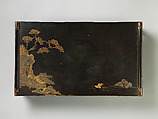Writing Desk (Bundai) with Landscape and Geese
Not on view
Lacquer writing desks were usually created in sets with boxes (suzuribako) to hold paper and writing implements. The earliest forms of the low table are documented in medieval handscroll paintings; most are undecorated and have shorter legs. The size and shape of the writing table became standardized in the Muromachi period (1392–1573) and remained unchanged through the Edo period, as seen in paintings representing Murasaki Shikibu at her desk composing The Tale of Genji. This desk, prepared in homage to earlier examples, has a landscape with a waterfall and geese among waves. The maki-e decoration covers only a small portion of the writing surface, in keeping with the desk’s function. The style of the sparse decoration recalls Japanese appreciation of Chinese ink paintings introduced by Zen monasteries.
This image cannot be enlarged, viewed at full screen, or downloaded.
This artwork is meant to be viewed from right to left. Scroll left to view more.



